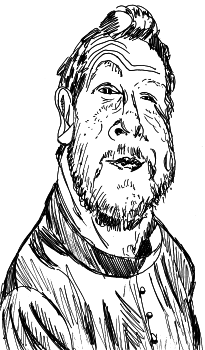|
I am now going to show you the biggest single impediment to the Easter faith [billiard ball].
|


|
|
It is, of course, a scale model, several billions time life size, of an atom. Not an atom as we understand it, you realise, but as Dalton understood it a few centuries ago. He suggested the entire universe was made up of these unsplittable objects, and that everything was made of things like this sort of stuck together. It was a good idea, except for one thing. People started to believe that everything real was a collection of tiny billiard balls, and that if you couldn't hit it with a stick, it was probably all make believe. And when they started to ask billiard ball questions about Easter, far from keeping their eye on the ball, they took their eye off it.
|
|
On Good Friday I said that there simply wasn't a single right answer to the question, 'What happened on the cross?' once you got beyond, 'There he would set free mankind', as the Dream of the Rood poem has it. Every theory they've come up with since made sense to its own generation, and the next generation spotted its shortcomings. On Easter Day, trying to come up with a 'What really happened?' is equally doomed to failure, but with the added twist that folk have tried to come up with an answer to the wrong question as well.
|
|
Trying to reconstruct the scene in the garden on Easter morning is a desperate attempt by fearful Christians to come up with the sort of answer to buy off the billiard ball believers. The argument goes something like this: 'If we can prove that the body wasn't in the tomb, then that will prove the rest of the story as well,' apparently not noticing two things: first, proving the tomb is empty only proves the tomb is empty. It does nothing for the truth of the rest of the Christian story. Secondly, it's something which the New Testament is not too concerned about, with the possible exception of a one-liner in Matthew.
|
|
And while we're fussing around writing letters to Channel 4 about programmes daring to ask whether the tomb WAS empty, we fail to note that we're being forced to play on ground not of our choosing, nor even of our tradition. Once we start to read the Scriptures and the tradition, what we see is that the Resurrection is not about emptiness where there should be a body: it is about something being there when no-one expects it, the exact opposite. The Easter Gospel is about unexpected and inexplicable meetings, and that single theme unites all the traditions and the writers, from earliest to latest. Why we've been billiard-ball-bamboozled into looking elsewhere is another story.
|
|
But these meetings in turn are not simple straightforward, "Ee, it's nice to see you again, Jesus, are you feeing better?" Note how across the traditions again these encounters are tentative, mysterious, often not understood until they are nearly over. "No-one dared asked him who he was," John 21 says. "Something prevented their eyes from recognising him," says Luke of the Emmaus Road travellers. Disciples in Matthew doubt what they see; Paul cries, "Who are you, Lord?" as he falls to the ground, and Mary thinks she is talking to a gardener. The unanimous witness of the New Testament directs our gaze away from the past, from the empty, from the absences, and towards the future, to places where Christ is known, briefly, tantalisingly, in his Risen form - and then is gone, leaving behind a changed being. "Did not our hearts burn within us?" "I have seen the Lord." "It was like an untimely birth."
|
|
Where billiard-ball controversies let us down particularly is that they keep us looking backward, focusing on a sort of 'happy ending to a sad story'. Good Friday, How Nasty - Just as well Easter Day put it all right (glossing over unpleasant things like pain and betrayal). It keeps the Resurrection nicely under control as something in the long-gone past. What the New Testament does is quite different. It forces us to look forward, to our own fleeting, ambiguous encounters with the Risen Christ, and see in them part of the turning back of death which began on Easter Day, part of the undoing of the work of darkness which began on the cross. Paul talks about the Resurrection as the first crop of the harvest of eternal life: it is the beginning of a story of victory, not past event, it is where the story of human woe and grief starts to be un-written, and that un-writing continues in us and in all witnesses of the Resurrection as we look, not for an empty tomb, but for a meeting with the Risen One.
|
|
In John 20, the disciples see the empty tomb and go running off. Mary hangs around waiting - and she sees the Resurrection. We are not called to be witnesses to an empty space, but to be partners in just such a meeting.
|

